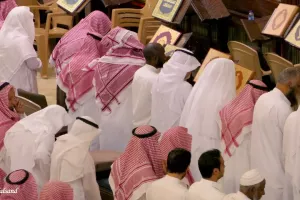This is a collection of pictures from Saudi Arabia. It is the result of a single trip to the large country on the Arabian Peninsula.
If you look into this link to Saudi Arabia, you will only find this article. In time, there will also be a travelogue with the content of the visit to the country and articles from three World Heritage Sites. For the time being, please settle with this collection of more than 200 pictures from Saudi Arabia.
Pictures from a trip across Saudi Arabia from east (Bahrain) to west (Jeddah) to a number of towns and places.
227 Photos
Fast facts
Learn about the country on Wikipedia. Here is a moderated excerpt:
The basics
Saudi Arabia, officially the Kingdom of Saudi Arabia (KSA), is a country in West Asia and the Middle East. It covers the bulk of the Arabian Peninsula and has a land area of about 2150000 km2, making it the fifth-largest country in Asia and the largest in the Middle East. The country has a population of more than 32 million. It is bordered by the Red Sea to the west. Jordan, Iraq, and Kuwait lies to the north. In the east we find the Persian Gulf and land borders with Qatar and the United Arab Emirates. Saudi Arabia also shares land borders with Oman to the southeast and Yemen to the south. Bahrain is a neighbouring island country off its east coast.
The Gulf of Aqaba in the northwest separates Saudi Arabia from Egypt and Israel. Saudi Arabia is the only country with a coastline along both the Red Sea and the Persian Gulf. Most of its terrain consists of arid desert, lowland, steppe, and mountains. The capital and largest city is Riyadh. The kingdom also hosts Islam’s two holiest cities of Mecca and Medina.
History
Pre-Islamic Arabia, the territory that constitutes modern-day Saudi Arabia, was the site of several ancient cultures and civilizations. The prehistory of Saudi Arabia shows some of the earliest traces of human activity outside Africa. The world’s second-largest religion, Islam, emerged in what is now Saudi Arabia. In the early 7th century, the Islamic prophet Muhammad united the population of the Arabian Peninsula. He created a single Islamic religious polity.
Following his death in 632, his followers expanded the territory under Muslim rule beyond Arabia, conquering territories in North Africa, Central, South Asia and Iberia in a matter of decades. Arab dynasties originating from modern-day Saudi Arabia founded the Rashidun (632–661), Umayyad (661–750), Abbasid (750–1517), and Fatimid (909–1171) caliphates, as well as numerous other dynasties in Asia, Africa, and Europe.
Regions and regime
The area of modern-day Saudi Arabia formerly consisted of mainly four distinct historical regions: Hejaz, Najd, and parts of Eastern Arabia (Al-Ahsa) and South Arabia (‘Asir). The Kingdom of Saudi Arabia was founded in 1932 by King Abdulaziz (known as Ibn Saud in the West). He united the four regions into a single state through a series of conquests beginning in 1902 with the capture of Riyadh, the ancestral home of his family, the House of Saud. It has since been an absolute monarchy. Political decisions are made on the basis of consultation among the King, the Council of Ministers, and the country’s traditional elites that oversee a highly authoritarian regime.
Religion
The ultraconservative Wahhabi religious movement within Sunni Islam was described as a “predominant feature of Saudi culture” until the 2000s. In 2016, the Saudi Arabian government curtailed the influence of the Wahhabi religious establishment and restricted the activities of the morality police. It also launched various Westernization policies such as the economic programme of Saudi Vision 2030.
In its Basic Law, Saudi Arabia defines itself as a sovereign Arab Islamic state with Islam as its official religion and Arabic as its official language.
An oil fueled economy
Petroleum was discovered in 1938 and followed up by several other finds in the Eastern Province. The country has since become the world’s third-largest oil producer and largest oil exporter, controlling the world’s second-largest oil reserves and the sixth-largest gas reserves. The kingdom is categorized as a World Bank high-income economy. It is the only Arab country to be part of the G20 major economies. The Saudi government has attracted criticism for various policies such as its intervention in the Yemeni Civil War, alleged sponsorship of terrorism as well as for its use of executions.
Saudi Arabia is considered both a regional and middle power. The Saudi economy is the largest in the Middle East. It is the world’s nineteenth-largest economy by nominal GDP and the seventeenth largest by PPP. As a country with a very high Human Development Index, it offers a tuition-free university education, no personal income tax, and a free universal health care system.
Population
With its dependency on foreign labour, Saudi Arabia is home to the world’s third-largest immigrant population. It also has one of the world’s youngest populations, with approximately 50% of its population of 32.2 million being under 25 years old.



